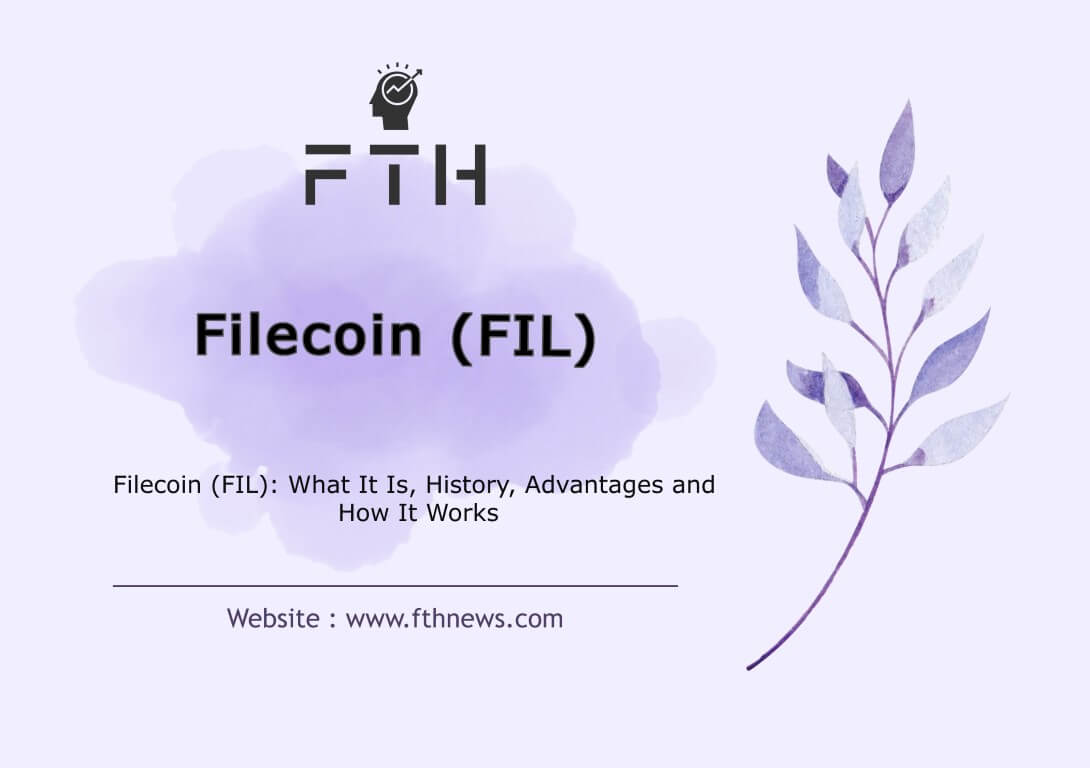
Filecoin (FIL): What It Is, Its History, Advantages, Future, and How It Works
Filecoin (FIL) The concept of secure and decentralized file storage has propelled FileCoin to a significant increase in value over recent years, capturing the attention of global investors. Cryptocurrency enthusiasts consider FileCoin to be one of the most intricate projects introduced by the blockchain industry. In this article, we’ll delve into the specifics of FileCoin, providing a comprehensive understanding of this digital currency. It’s crucial to possess in-depth knowledge about a digital currency to navigate its nuances and potentially profit from buying and selling.
What is FileCoin (FIL) Digital Currency?
FileCoin (FIL) stands as a decentralized storage system and sharing network, introducing numerous opportunities for users within the market through the utilization of blockchain technology. The rise of decentralized sharing platforms has been a prevailing trend, and FileCoin leverages various technologies to offer a unique experience, creating additional avenues for earning cryptocurrency.
At its core, FileCoin operates similarly to mainstream file-sharing platforms like Dropbox. The key distinction lies in users opting to store information within the FileCoin network, eschewing centralized information storage authorities in favor of utilizing storage space provided by miners.
This innovative approach not only enhances the security and privacy of file storage but also demonstrates a novel application of blockchain technology extending beyond traditional financial use cases. As we explore FileCoin further, it becomes evident that its decentralized nature plays a pivotal role in reshaping how we perceive and interact with digital assets.
The History of FileCoin Digital Currency
FileCoin, as a digital currency, emerges as a solution to traditional online storage protocols. Its underlying technology operates as an incentive layer within the peer-to-peer file transfer system, known as the InterPlanetary File System (IPFS). The primary objective of this technology is to mitigate congestion, enhance durability, and optimize efficiency. Unlike conventional storage methods reliant on centralized servers and IP addresses, FileCoin employs hash-addressed content structures.
The network’s innovative approach involves rewarding storage providers and recovery authorities for contributing system resources, fostering a peer-to-peer ecosystem. Furthermore, FileCoin serves as an incentive for IPFS, incentivizing its adoption and utilization. Notably, the network seamlessly integrates with Ethereum, allowing developers to access Ethereum blockchain data and engage with its smart contracts.
FileCoin’s inception can be traced back to the developer company Protocol Labs, founded in 2014 by Juan Benet. Benet, a scientist and computer science expert, led the development of both FileCoin and IPFS simultaneously, securing several rounds of funding to support these groundbreaking initiatives.
Protocol Labs envisions creating a foundational layer for data infrastructure, applicable to both blockchain and traditional service providers such as Amazon Web Services and Microsoft Azure. Juan Benet’s commitment to this vision spurred the quiet and diligent work on FileCoin for three years within the Protocol Labs Foundation before its official introduction.
Despite its unassuming beginnings, FileCoin gained prominence when it was introduced through an Initial Coin Offering (ICO) in 2017. Originally slated for a first-quarter 2019 launch, the digital currency encountered delays, pushing its official debut to October 2020. FileCoin then made its debut on digital currency exchanges with the abbreviation FIL, marking a significant milestone after three years of dedicated development and preparation.
Release of the First Filecoin Token
The inaugural release of (FIL) tokens spanned a month, marking a noteworthy event in cryptocurrency history. What captured attention during this initial offering was the staggering capital of $250 million it attracted, setting a record at the time. Notably, the Initial Coin Offering (ICO) was exclusively available to accredited investors, as per the definition outlined by US regulations. This meant that participants in the ICO were individuals with incomes exceeding $200,000 or net worth surpassing $1 million. While FileCoin made efforts to showcase its compliance with existing regulations, the decision to exclude retail investors left some members of the community disheartened. Investors, however, had the flexibility to lock in their tokens for varying durations, enabling them to benefit from early purchase discounts.
Getting to Know Filecoin’s White Paper
In 2017, the developers of FileCoin unveiled a comprehensive roadmap outlining the project’s trajectory, and this roadmap has remained unchanged since its introduction. The cornerstone of FileCoin’s informational foundation is its 36-page white paper, a detailed document elucidating the acquisition of FileCoin tokens, the functioning of miners within the network, and an overview of the network’s operations. This white paper serves as a vital resource for understanding the intricacies of FileCoin, providing stakeholders with valuable insights into its underlying principles and mechanisms.
Reasons for the Need for Decentralized Storage in FileCoin
While various blockchain projects emerge, the integration of blockchain technology into cloud computing and data storage hasn’t received the attention it deserves. Perhaps the discussion of data storage appears mundane, resulting in projects like FileCoin not garnering as much attention as some others. However, decentralized storage presents significant advantages compared to centralized methods. Two crucial reasons underscore the necessity for decentralized storage:
1. Vulnerability of Centralized Storage Platforms
Centralized storage solutions, such as Dropbox and Google, are susceptible to attacks. If a hacker breaches the security of these centralized networks, they gain access to all stored data, including sensitive information like financial details and passwords. The potential theft of such data can lead to severe consequences. FileCoin, with its ambitious goal of revolutionizing data storage, offers a decentralized alternative. The project’s blockchain structure and unique features instill confidence among experts, indicating a promising future.
2. High Storage Costs
FileCoin employs storage miners, robust computers committed to storing data efficiently over a specified period. Individuals looking to store their files or earn money by saving others’ files can join the network, with customers paying miners for storage. Unlike Bitcoin ESICs, FileCoin doesn’t rely on specialized and expensive hardware, making it more accessible. This inclusive approach allows even those with less serious intentions to participate in mining with a nominal fee.
Decentralized Storage Features
A notable aspect of FileCoin is content addressing. Traditional centralized storage systems rely on location-based addressing, whereas FileCoin prioritizes files and content over location. This content-addressing storage enhances access speed and flexibility, making the network more secure than centralized alternatives.
FileCoin encrypts information, divides it into smaller pieces, and distributes these pieces across different nodes. Only users with the private key can reassemble the data. Redundancy in storage nodes handles potential errors during storage and reassembly. Additionally, FileCoin’s unique approach allows the sharing of files among different users through the utilization of web3 technology.
What is Web3 and How Does it Work?
Web3 is the software enabling FileCoin’s blockchain to facilitate file sharing among users. Essentially, web3 transforms centralized applications into decentralized ones, minimizing the risk of information hacking or censorship by eliminating intermediaries. Embracing web3 technology ensures customers that their information will be stored securely and can be retrieved when needed. This added layer of security and decentralization marks a significant advancement in how data is managed and shared within the FileCoin ecosystem.
How Filecoin Currency Works
The Filecoin ecosystem operates by allowing users to lease storage space on existing devices through the native cryptocurrency of the network, FIL. Users within the Filecoin network fall into three distinct categories:
1. Clients
Clients are users seeking storage space within the blockchain to store their data, and they compensate for this service using FIL. they have the flexibility to utilize one or multiple storage spaces based on their requirements. Additionally, clients can choose to encrypt their data before storing it, enhancing the security of their information.
2. Storage Miners
Storage Miners are users who contribute storage space to the network and, in turn, receive FIL cryptocurrency as compensation. This currency serves to record transactions related to payments and the transfer of FIL, ensuring the accuracy of the storage process within the network. Storage Miners play a crucial role in maintaining the decentralized and secure nature of Filecoin’s storage infrastructure.
3. Retrieval Miners
Retrieval Miners are responsible for retrieving information from storage and making it available to clients when required. These miners can obtain information from both clients and storage miners, providing a seamless and efficient data retrieval process. It’s worth noting that Retrieval Miners can also serve as Storage Miners within the Filecoin network, showcasing the versatility of participants.
As of now, any user can join and utilize the Filecoin network. This inclusivity enhances the network’s accessibility, allowing a diverse range of participants to engage with its storage and retrieval capabilities. Moreover, for those interested in delving into the technical details, the open-source code of the project is available, providing a comprehensive resource for gaining deeper insights into the workings of Filecoin. This commitment to transparency and openness further contributes to the project’s credibility and appeal within the blockchain community.
Applications and Features of FileCoin
FileCoin emerges as a groundbreaking solution addressing concerns in the file-sharing and cloud storage domain, aiming to mitigate potential risks associated with centralization and the control of information by powerful technology entities. The network achieves this by distributing information in the form of separate parts, known as Sectors, across computers worldwide. When required, Retrieval Miners retrieve and make this information available, contributing to a secure and decentralized approach.
1. Peer-to-Peer Network of Storage Nodes
FileCoin utilizes blockchain technology to raise funds and establish a peer-to-peer network of storage nodes. While (FIL) is not the sole contender in this field, it has proven successful in attracting users and is perceived as a secure solution for information storage.
2. Decentralized Cloud Storage
FileCoin serves as the world’s response to centralized cloud storage. Unlike relying on a single company like Amazon or Google, FileCoin enables users to share their private storage across multiple computers globally. This decentralized approach not only provides freedom for large enterprises but also offers storage providers the opportunity to earn FIL in accordance with their contributions.
How to Store FileCoin (FIL)
For those invested in FileCoin or supportive of the project, having an effective and secure (FIL) wallet is essential. While specialized (FIL) wallets are recommended for the best security, various crypto wallets with different features can also be used.
FileCoin Wallets:
FilFox: FilFox is a dedicated FileCoin wallet, facilitating the storage, sending, and withdrawal of FIL tokens.
Other Wallets Compatible with FileCoin:
- Software Wallets:
- Trust Wallet
- Atomic Wallet
- Math Wallet
- Im Token Wallet
- Hardware Wallets:
- Ledger Nano S Wallet
- Ledger Nano X Wallet
Selecting the right wallet depends on individual preferences and needs. Specialized wallets like FilFox offer a focused and secure solution, while other wallets may provide additional features and compatibility. It’s crucial to prioritize security and choose a wallet that aligns with the specific requirements and beliefs in the FileCoin project
FileCoin (FIL) Currency Mining
FileCoin introduces a unique mining process that allows users to earn FIL tokens by providing data storage and retrieval services within its global network. Here’s an overview of the key aspects of FileCoin mining:
1. Earning FIL Tokens:
- Users can earn FIL tokens by offering data storage and retrieval services to others on the global network.
2. Storage Power and Block Production:
- The more data a miner stores, the higher their storage power.
- Increased storage power enhances the probability of producing a new block in the blockchain and receiving rewards.
- Miners can choose to participate in storage mining, retrieval mining, storage power consensus, or a combination of these.
3. Consensus Mechanism:
- FileCoin mining differs from traditional proof-of-work blockchains. It operates on the consensus of storage power.
- The more proven storage a miner contributes to the network, the higher the likelihood of receiving block completion rewards.
4. Linear Storage Power:
- Storage power increases linearly with the amount of space added to the network by each miner.
- Unlike proof-of-work blockchains where GPU power determines competitiveness, FileCoin’s platform doesn’t rely on the number of GPUs.
5. Equipment Needed for Mining FIL Cryptocurrency:
- Lotus Client: Software for interacting with the Filecoin network.
- CPU: Central Processing Unit.
- GPU: Graphics Processing Unit.
- RAM: Random Access Memory.
- Storage: Storage space for data.
- Internet: Stable and reliable internet connection.
6. Certification of Miners:
- All miners must post collateral to demonstrate good faith and commitment.
- The proof-of-space algorithm (PoSt) verifies a miner’s activity over an acceptable period.
- A miner’s credit in Filecoin is determined by their use of space and active time on the network.
Note: The FileCoin mining process focuses on the contribution of storage space rather than the computational power typically associated with traditional proof-of-work blockchains. This unique approach aims to create a fair and efficient ecosystem for users participating in storage and retrieval services within the FileCoin network.
Advantages of FileCoin Digital Currency
FileCoin stands out as a compelling system for file storage, offering a range of features and advantages that contribute to its appeal in the digital currency landscape. Here are some notable advantages:
1. Rewarding Miners for Free Space:
- FileCoin rewards its miners for providing storage space, ensuring that the blockchain always maintains available space for storing additional information.
2. Customer Choice and Flexibility:
- Customers within the FileCoin network can select a miner based on their specific needs, considering factors such as cost and speed that align with individual preferences.
3. Unified API for Storage:
- Unlike centralized storage systems, FileCoin eliminates the need for implementing a different API for each storage provider, streamlining the integration process.
4. No Network-Level Advertising Requirement:
- Users in the FileCoin network do not need to advertise their miners at the network level to attract customers, simplifying the user experience.
5. Inclusive Mining Rewards:
- Newcomers to the FileCoin blockchain can enter the mining process without concerns about their rewards. The system is designed to ensure that newcomers can consistently benefit from digital currency mining rewards.
6. Secure Storage and Distribution:
- FileCoin provides a secure and reliable environment for the storage and distribution of valuable resources such as encyclopedias, historical documents, and literary articles.
7. Built-In File History Verification:
- Filecoin incorporates processes to check the history of files, ensuring proper storage over time. Storage miners provide proof of file storage within a 24-hour window, allowing customers to verify the integrity of their stored files even when offline.
8. Competitive Pricing:
- The pricing of storage and recovery on (FIL) is determined by supply and demand, avoiding special pricing structures by the company. This results in reliable storage available at reasonable and competitive prices.
FileCoin’s innovative features not only address current challenges in the file storage industry but also contribute to a secure, flexible, and inclusive environment for both users and miners within its decentralized network.
Use Cases and Technological Advancements of FileCoin
Use Cases:
- Buying and Selling Data:
- FileCoin facilitates transactions in data-based markets and exchanges, providing a decentralized platform for buying and selling data.
- Secure Storage and Distribution:
- Ensures safe and secure storage and distribution of valuable resources such as encyclopedias, historical documents, and literary articles.
- Blockchain Services:
- Provides blockchain services, including storage for distributed ledgers, supply chains, and decentralized applications (dApps).
- Token-Based Purchases:
- Facilitates services related to paying for the purchase of goods through the FileCoin token.
- Long-Term Storage:
- Ideal for the long-term storage of large amounts of customer data in a decentralized manner.
- Decentralized Cloud Storage:
- Serves as a decentralized alternative for storing valuable data, challenging traditional cloud storage services.
Collaborations and Network Growth:
In July 2020, the Truffle Suite main network announced support for FileCoin, enabling users to utilize the storage space provided by FileCoin miners globally to build dApps with full power.
In October 2020, a collaboration with ConsenSys integrated the FileCoin distribution market with ConsenSys Ethereum, providing affordable storage options to millions of users.
Over 70 organizations have created or cooperated with FileCoin, contributing to the network’s growth, with storage capacity exceeding 1 petabyte by November 2020.
Technological Advancements:
1. Decentralized Storage Network (DSN):
- DSN enables independent storage providers to offer storage and retrieval services using an incentive model, enhancing decentralization.
2. Consensus Mechanism:
- FileCoin employs Proof-of-Replication (PoRep) and Proof-of-Spacetime (PoSt) algorithms as unique consensus mechanisms, ensuring the decentralized storage and retrieval network’s security and efficiency.
3. Storage and Retrieval Markets:
- Reliable markets for storage and retrieval ensure that FileCoin receives fees related to services provided by storage space providers, fostering a dynamic ecosystem.
4. Smart Contracts:
- FileCoin incorporates smart contracts, enabling users to code stateful programs for user-defined operations. Smart contracts facilitate market operations, authorization, and token usage, empowering users with programmable functionalities.
By leveraging these technological innovations, (FIL) addresses the challenges posed by centralized storage systems, offering a secure, efficient, and decentralized alternative for storing and retrieving information.
FAQ
(FIL) is a decentralized storage network allowing users to rent and earn FIL tokens by providing and accessing storage space on a global scale.
Investment decisions depend on individual goals and risk tolerance, but (FIL) has garnered attention for its innovative approach to decentralized storage.
The future of (FIL) looks promising, with its unique features and growing collaborations positioning it as a significant player in decentralized storage solutions.
(FIL) miners earn FIL tokens by providing storage and retrieval services, and users pay in FIL for accessing storage on the network.
(FIL) is not specific to any country; it’s a global decentralized storage cryptocurrency created by Protocol Labs, a US-based company.
(FIL) competes with other decentralized storage projects like IPFS, Sia, and Storj, as well as traditional cloud storage providers like Amazon S3 and Google Cloud Storage.














